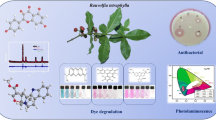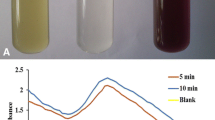Abstract
Gold nanoparticles have found their application as optical probes, antibacterial agents, catalyst and sensors. Here, we report the synthesis of gold nanoparticles (GNPs) using leaf extract (LE) of three different plants viz., Populus alba (PA), Lantana camara (LC) and Hibiscus arboreus (HA). The effect of reaction temperature and concentration of leaf extracts (LEs) were studied in detail on the synthesis and size of GNPs. The prepared GNPs were chemically characterized by UV–Vis and FTIR whereas the morphological analysis was done using DLS, TEM and SEM. When 5% PA LE was used at 65 °C, almost uniform shaped GNPs were obtained of size ~ 16.3 ± 0.7 nm. The as prepared GNPs showed antibacterial activity against both Staphylococcus aureus and Escherichia coli with MIC value of ~ 100 µg/ml. Further, these GNPs were also used for the degradation of toxic dyes viz., methylene blue (MB) and congo red (CR). Overall, present studies suggested the use of green synthesized GNPs in both biomedical and analytical field.




Similar content being viewed by others
References
Abdal Dayem A, Hossain MK, Lee SB, Kim K, Saha SK, Yang GM, Cho SG (2017) The role of reactive oxygen species (ROS) in the biological activities of metallic nanoparticles. Int J Mol Sci 18(1):120
Ahn EY, Hwang SJ, Choi MJ, Cho S, Lee HJ, Park Y (2018) Upcycling of jellyfish (Nemopilema nomurai) sea wastes as highly valuable reducing agents for green synthesis of gold nanoparticles and their antitumor and anti-inflammatory activity. Artif Cells Nanomed Biotechnol 46(sup2):1127–1136
Ajah HA, Khalaf KJ, Hassan AS, Aja HA (2018) Extracellular biosynthesis of silver nanoparticles by Haemophilus influenzae and their antimicrobial activity. J Pharm Sci Res 10(1):175–179
Anandan M, Poorani G, Boomi P, Varunkumar K, Anand K, Chuturgoon AA, Saravanan M, Prabu HG (2019) Green synthesis of anisotropic silver nanoparticles from the aqueous leaf extract of Dodonaea viscosa with their antibacterial and anticancer activities. Process Biochem 80:80–88
Ananthi V, John A (2019) Biosynthesis and charecterization of gold nanoparticles using aqueous leaf extract of Cajanus cajan. World J Pharm Res 8(3):1195–1204
Annamalai A, Christina VLP, Sudha D, Kalpana M, Lakshmi PTV (2013) Green synthesis, characterization and antimicrobial activity of Au NPs using Euphorbia hirta L. leaf extract. Colloids Surf B 108:60–65
Artanti AN, Rahmadanny N, Prihapsara F (2018) Radical scavenging activity from ethanolic extract of malvaceae family’s flowers. IOP Conf Ser Mater Sci Eng 349(1):012006
Dakshayani SS, Marulasiddeshwara MB, Kumar S, Golla R, Devaraja SRHK, Hosamani R (2019) Antimicrobial, anticoagulant and antiplatelet activities of green synthesized silver nanoparticles using Selaginella (Sanjeevini) plant extract. Int J Biol Macromol 131:787–797
Dubey SP, Lahtinen M, Sillanpää M (2010) Tansy fruit mediated greener synthesis of silver and gold nanoparticles. Process Biochem 45(7):1065–1071
Gao Y, Wu Y, Di J (2017) Colorimetric detection of glucose based on gold nanoparticles coupled with silver nanoparticles. Spectrochim Acta Part A Mol Biomol Spectrosc 173:207–212
Gayda GZ, Demkiv OM, Stasyuk NY, Serkiz RY, Lootsik MD, Errachid A, Gonchar MV, Nisnevitch M (2019) Metallic nanoparticles obtained via “green” synthesis as a platform for biosensor construction. Appl Sci 9(4):720
Ghosh B, Ramamoorthy D (2010) Effects of silver nanoparticles on Escherichia coli and its implications. Int J Chem Sci 8(5):S31–S40
Jha AK, Prasad K, Kumar V, Prasad K (2009) Biosynthesis of silver nanoparticles using Eclipta leaf. Biotechnol Prog 25(5):1476–1479
Kanjanawarut R, Yuan B, XiaoDi S (2013) UV–Vis spectroscopy and dynamic light scattering study of gold nanorods aggregation. Nucleic Acid Therap 23(4):273–280
Kasthuri J, Kathiravan K, Rajendiran N (2009) Phyllanthin-assisted biosynthesis of silver and gold nanoparticles: a novel biological approach. J Nanopart Res 11(5):1075–1085
Kim SH, Lee HS, Ryu DS, Choi SJ, Lee DS (2011) Antibacterial activity of silver-nanoparticles against Staphylococcus aureus and Escherichia coli. Korean J Microbiol Biotechnol 39(1):77–85
Kumar KP, Sharma PW (2007) Green synthesis of gold nanoparticles with Zingiber officinale extract: characterization and blood compatibility. Process Biochem 46:10
Kumar V, Yadav SC, Yadav SK (2010) Syzygium cumini leaf and seed extract mediated biosynthesis of silver nanoparticles and their characterization. J Chem Technol Biotechnol 85(10):1301–1309
Kumar V, Wadhwa R, Kumar N, Maurya PK (2019) A comparative study of chemically synthesized and Camellia sinensis leaf extract-mediated silver nanoparticles. 3 Biotech 9(1):7
Kumari A, Guliani A, Singla R, Yadav R, Yadav SK (2014) Silver nanoparticles synthesised using plant extracts show strong antibacterial activity. IET Nanobiotechnol 9(3):142–152
Laoufi I, Saint-Lager MC, Lazzari R, Jupille J, Robach O, Garaudée S, Cabailh G, Dolle P, Cruguel H, Bailly A (2011) Size and catalytic activity of supported gold nanoparticles: an in operando study during CO oxidation. J Phys Chem C 115(11):4673–4679
Lateef A, Ojo SA, Elegbede JA, Azeez MA, Yekeen TA, Akinboro A (2017) Evaluation of some biosynthesized silver nanoparticles for biomedical applications: hydrogen peroxide scavenging, anticoagulant and thrombolytic activities. J Cluster Sci 28(3):1379–1392
Li S, Shen Y, Xie A, Yu X, Qiu L, Zhang L, Zhang Q (2007) Green synthesis of silver nanoparticles using Capsicum annuum L. extract. Green Chem 9(8):852–858
Mata R, Bhaskaran A, Sadras SR (2016) Green-synthesized gold nanoparticles from Plumeria alba flower extract to augment catalytic degradation of organic dyes and inhibit bacterial growth. Particuology 24:78–86
Morones JR, Elechiguerra JL, Camacho A, Holt K, Kouri JB, Ramírez JT, Yacaman MJ (2005) The bactericidal effect of silver nanoparticles. Nanotechnology 16(10):2346
MubarakAli D, Thajuddin N, Jeganathan K, Gunasekaran M (2011) Plant extract mediated synthesis of silver and gold nanoparticles and its antibacterial activity against clinically isolated pathogens. Colloids Surf B 85(2):360–365
Nadaf NY, Kanase SS (2019) Biosynthesis of gold nanoparticles by Bacillus marisflavi and its potential in catalytic dye degradation. Arab J Chem 12(8):4806–4814
Narayanan KB, Park HH, Han SS (2015) Synthesis and characterization of biomatrixed-gold nanoparticles by the mushroom Flammulina velutipes and its heterogeneous catalytic potential. Chemosphere 141:169–175
Nasrollahzadeh M, Issaabadi Z, Sajadi SM (2018) Green synthesis of a Cu/MgO nanocomposite by Cassytha filiformis L. extract and investigation of its catalytic activity in the reduction of methylene blue, congo red and nitro compounds in aqueous media. RSC Adv 8(7):3723–3735
Negi GCS, Sharma S, Vishvakarma SC (2019) Ecology and use of Lantana camara in India. Bot Rev 85:109–130
Noruzi M (2015) Biosynthesis of gold nanoparticles using plant extracts. Bioprocess Biosyst Eng 38(1):1–14
Park Y, Hong YN, Weyers A, Kim YS, Linhardt RJ (2011) Polysaccharides and phytochemicals: a natural reservoir for the green synthesis of gold and silver nanoparticles. IET Nanobiotechnol 5(3):69–78
Qi M, Liu Y, Li T (2013) Nano-TiO2 improve the photosynthesis of tomato leaves under mild heat stress. Biol Trace Elem Res 156(1–3):323–328
Raffi M, Hussain F, Bhatti TM, Akhter JI, Hameed A, Hasan MM (2008) Antibacterial characterization of silver nanoparticles against E. coli ATCC-15224. J Mater Sci Technol 24(2):192–196
Rajakumar G, Rahuman AA (2011) Larvicidal activity of synthesized silver nanoparticles using Eclipta prostrate leaf extract against filariasis and malaria vectors. Acta Trop 118:196–203
Rao Y, Inwati GK, Singh M (2017) Green synthesis of capped gold nanoparticles and their effect on Gram-positive and Gram-negative bacteria. Future Sci OA(3):FSO239
Shankar SS, Rai A, Ahmad A, Sastry M (2004) Rapid synthesis of Au, Ag, and bimetallic Au core–Ag shell nanoparticles using Neem (Azadirachta indica) leaf broth. J Colloid Interface Sci 275(2):496–502
Singhal G, Bhavesh R, Kasariya K, Sharma AR, Singh RP (2011) Biosynthesis of silver nanoparticles using Ocimum sanctum (Tulsi) leaf extract and screening its antimicrobial activity. J Nanopart Res 13(7):2981–2988
Singla R, Soni S, Kulurkar PM, Kumari A, Mahesh S, Patial V, Padwad YS, Yadav SK (2017) In situ functionalized nanobiocomposites dressings of bamboo cellulose nanocrystals and silver nanoparticles for accelerated wound healing. Carbohydr Polym 155:152–162
Song JY, Kim BS (2009) Rapid biological synthesis of silver nanoparticles using plant leaf extracts. Bioprocess Biosyst Eng 32(1):79
Sousa EO, Miranda CM, Nobre CB, Boligon AA, Athayde ML, Costa JG (2015) Phytochemical analysis and antioxidant activities of Lantana camara and Lantana montevidensis extracts. Ind Crops Prod 70:7–15
Tawfeek N, Sobeh M, Hamdan DI, Farrag N, Roxo M, El-Shazly AM, Wink M (2019) Phenolic compounds from Populus alba L. and Salix subserrata Willd.(Salicaceae) counteract oxidative stress in Caenorhabditis elegans. Molecules 24(10):1999
Vijayan R, Joseph S, Mathew B (2018) Indigofera tinctoria leaf extract mediated green synthesis of silver and gold nanoparticles and assessment of their anticancer, antimicrobial, antioxidant and catalytic properties. Artif Cells Nanomed Biotechnol 46(4):861–871
Walia S, Shukla AK, Sharma C, Acharya A (2019) Engineered bright blue-and red-emitting carbon dots facilitate synchronous imaging and inhibition of bacterial and cancer cell progression via 1O2-mediated DNA damage under photoirradiation. ACS Biomater Sci Eng 5(4):1987–2000
Wang H, Cheng H, Wang F, Wei D, Wang X (2010) An improved 3-(4,5-dimethylthiazol-2-yl)-2, -diphenyl tetrazolium bromide (MTT) reduction assay for evaluating the viability of Escherichia coli cells. J Microbiol Methods 82(3):330–333
Wang C, Mathiyalagan R, Kim YJ, Castro-Aceituno V, Singh P, Ahn S, Wang D, Yang DC (2016) Rapid green synthesis of silver and gold nanoparticles using Dendropanax morbifera leaf extract and their anticancer activities. Int J Nanomed 11:3691
Zeng S, Yu X, Law WC, Zhang Y, Hu R, Dinh XQ, Ho HP, Yong KT (2013) Size dependence of Au NP-enhanced surface plasmon resonance based on differential phase measurement. Sensors Actuators B Chem 176:1128–1133
Acknowledgements
The authors are thankful to the Director, CSIR-IHBT for infrastructural facilities. AA acknowledges the financial support from DST (EMR/2016/003027, GAP 0214) and CSIR (MLP0201). The CSIR-IHBT communication number of this manuscript is 4594.
Author information
Authors and Affiliations
Corresponding author
Ethics declarations
Conflict of interest
The authors declare that they have no conflict of interest.
Additional information
Editorial responsibility: Samareh Mirkia.
Supplementary Information
Below is the link to the electronic supplementary material.
Rights and permissions
About this article
Cite this article
Guliani, A., Kumari, A. & Acharya, A. Green synthesis of gold nanoparticles using aqueous leaf extract of Populus alba: characterization, antibacterial and dye degradation activity. Int. J. Environ. Sci. Technol. 18, 4007–4018 (2021). https://doi.org/10.1007/s13762-020-03065-5
Received:
Revised:
Accepted:
Published:
Issue Date:
DOI: https://doi.org/10.1007/s13762-020-03065-5




